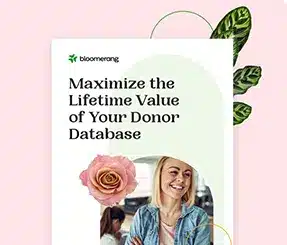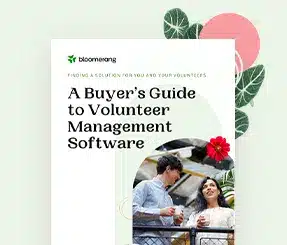Your Opportunity Knocks: Get Started with Bequest Fundraising


Full Platform Overview Chat With Us



Full Platform Overview Chat With Us





Bequests account for 9% of all fundraising per Giving USA.
Have you allocated at least 9% of your development budget towards promoting bequests?
If not, have you allocated any budget at all to this supremely cost-effective fundraising strategy?
Have you been meaning to get around to doing more about building a legacy giving program?
Never put off ‘til tomorrow what you can do today.
Especially in this case. Because… There’s NO more cost-effective form of fundraising in the long-term.
Here are some stats to share with anyone in your organization who may be dragging their feet:
That’s the point. Long term.
If you’ve been around for 10 years or more, you should be thinking long term.
Even if you feel you’re living payroll to payroll, there are valid ethical and practical reasons why you must look forward with your fundraising.
I used this inspiring and thoughtful story when I began the legacy giving program for Jewish Family and Children’s Services of San Francisco, the Peninsula, Marin and Sonoma Counties. In fact, we named our legacy giving society the ‘Carob Tree Society.’
There’s a Talmudic story that tells of a man who planted a carob tree. Asked when he thought the tree would bear fruit he replied, “After seventy years.” When asked then whether he expected to personally benefit he responded, “I did not find the world desolate when I entered it, and as others have planted before me, so do I plant for those who will come after.”
People can understand and relate to the concept of planting a tree that will grow and provide fruit, shade and beauty for future generations.
It makes them feel good.
Because philanthropy is largely a social act.
An act of taking care of others. Of doing unto others what you would have done unto you.
In fact, research from Russell James on phrases that encourage planned gifts shows of the following three phrases, the one that talks about assuring your values live on past your own lifetime significantly outperforms all others:
Bequest fundraising is not rocket science. All you have to do is ask people to consider leaving a gift to you after they no longer need the money. And anyone can leave a bequest.
People don’t need to be John Rockefeller, Bill Gates or Mark Zuckerberg to leave a bequest.
In fact, most legacy donors are not major annual donors. They’re folks who care a lot about what you do, but who weren’t able to make significant gifts during their lifetime. Their legacy gift will be the largest charitable contribution they’ll ever make. Sometimes legacy gifts from these donors can be well over $1 million (e.g., they leave you their house when they die). Sometimes they may leave you a gift of $5,000.
As I learned over 30 years ago talking with a development director at my local YMCA (where their average bequest was $20,000, meaning for every 50 gifts they received $1 million), when it comes to average bequest gift size, some folks give a lot more; some a lot less.
But … small amounts add up.
Not everyone has resources to hire one person who does nothing but bequest fundraising (or planned giving or deferred giving.) And, truth be told, you don’t need to do that.
What you do need to do is this:
Make this part of someone’s job description.
If no one’s feet are being held to the fire, it’s likely little will get done. It’s just human nature, alas.
Incorporate bequest fundraising goals, objectives and strategies into your overall written development strategic plan.
Not things you can’t control (like when someone may die and how much they might leave you in a particular year). Things you can control (like to whom, how, when and where you’ll promote the fact that you accept bequests).
Describe how much money is out there:
Assure management and board you have legacy donors hiding in plain sight.
Segment your database so you can target communications to your best donor prospects moving forward. Not all donors are equally likely to think about making a bequest, and you don’t want insiders thinking because they’d never do it, it’s something that can’t be done. Explain how consistent, loyal, affiliated supporters – especially those who are older, and particularly those who are childless — are the most likely to be receptive to bequest fundraising and promotions.
Look at donors who’ve given five years consecutively. Look at donors who gave at least two donations in the past 18 months. Look at donors who are also engaged with you elsewhere. Look at any information you may have recorded that gives you an idea of what floats your donors’ boat.
Prospecting: What should you focus on?
Marketing: What should you not focus on?
Budgeting: Do the math:
You can’t afford to miss this opportunity.
“Opportunity cost” is the money you would have raised if you’d done things right.” – Mal Warwick
Whether you miss out on $7.8 million or $1.56 million or $15.6 million, you’re missing out. Big time. And you don’t have to do much to avail yourself of this big opportunity.
While in the past it was not uncommon to receive bequests seemingly out of the blue, from folks who made no annual gifts to you, increasingly bequests are being received from current and past donors. One may assume it’s because charities are getting better at communicating, across multiple channels. When no one is asking for bequests, donors are left to their own devices. When lots of charities are asking, it’s likely folks will give to one of them. So it makes sense to actively ask folks if they’ll consider a gift to you in their will.
Here are some direct strategies:
Here are some more indirect strategies:
Every marketing strategy costs money. And, don’t forget, time is also money. Once you’ve determined your best strategies (i.e., those you’ve decided will reach your segmented target markets), budget money to enable you to implement these strategies.
Just like with any other fundraising campaign, you must give donors an emotional reason to give. Simply focusing on the way they’ll leave a donation (via bequest) is not sufficient to motivate a legacy gift. Whether it presents a visionary proposition, this is your opportunity to be less tangible and more big-picture and future thinking in your approach.
It’s critical to stay in touch with legacy donors and keep them happy. Why? Generally bequests are revocable. So you want to keep folks loyal!
If you look at the (1) data from Giving USA, or at the (2) average bequest gift (see above), or at the (3) planned giving likelihood hiding in your own database, you’ll see opportunity is already knocking. If you’re not opening the door, ask yourself why this may be the case.
Are you simply afraid to raise the subject of mortality with donors? Don’t be! Your best prospects have already demonstrated they care about your mission and vision. Also, many will be elderly – and they’re used to talking about death. And life. And the journey they’re on. Part of that journey is they’ve given to you loyally (either as donors, volunteers or staff). They are engaged with you and want to know the best way they can help. Let them know they can leave you a bequest!
The main reason people don’t leave a bequest is they aren’t asked.
Try this: Hold a series of intimate luncheons for targeted prospects who’ve already demonstrated their love for your cause. After you’ve showcased your mission and reminded them why they support you (get them feeling like the heroes they are!), follow up by asking how many have included a gift in their wills for your benefit. (Usually you’ll find very few have.) Ask them why. (Usually they’ll say they never even considered it; no one asked). Apologize for not making it clear to them how much this support would be welcomed; ask them if they’d be willing to consider doing so now. By so doing, they’ll be able to perpetuate the values they expressed during their life. Tell them you’ll follow up with them individually to talk about how bequest giving might fit with their personal and financial goals. I did this once for a 40th anniversary campaign where we were seeking 40 new bequests. We hosted 10 luncheons with 8 guests each. Guest how many of the attendees ended up making provision for our charity in their will or trust? Fifty percent! Yup. We made our goal.
You ask for annual gifts, don’t you? You budget for this, don’t you?
You need to do the same thing with bequests. Per Russell James: “Among organizations receiving any gifts from wills or estates, on average organizations receive an almost 50% greater share of gift income from such gifts than the share of total fundraising they devote to such fundraising.”
The primary reasons folks don’t make legacy gifts, per several studies, is because (1) they aren’t persuaded they’re necessary and (2) they aren’t asked.
Purely on the basis of economics you should be opening the door to active bequest fundraising, marketing, and solicitation. But there’s more.
People love to give, and your job as a fundraiser is to facilitate the joy of giving. You do a good deed when you let folks know there’s another way they can support your mission. It’s likely something they haven’t thought about before – so it opens the door for them too!

Comments